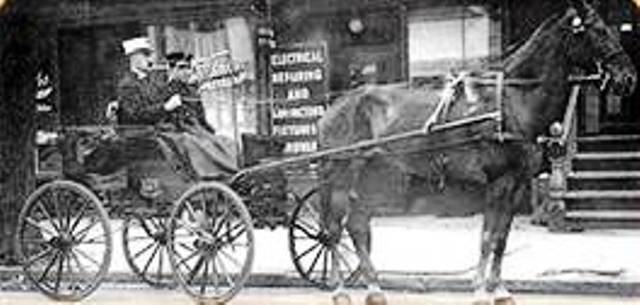
“Whirling over icy streets, skidding on wet pavements, many times wheels were smashed and the chief and his driver [ John Rush ] missed death or injury by inches.”–The New York Sun, April 26, 1912

As the personal chauffeur for New York Fire Department Chief Edward Croker in the early 1900s, John Rush earned the nickname Dare-Devil Rush. Fellow firemen often made bets that Chief Croker’s wild horse, Bullet, would determine the fate of John Rush.
In later years, only a few believed that he would survive while driving Croker’s high-power automobile 50 miles an hour through the city’s congested streets.
No one ever dreamed that Battalion Chief John Rush would be killed while driving leisurely home for lunch on a buggy harnessed to Victor, the horse of Engine Company No. 30 at 278 Spring Street.
The Rapid Rise of Fire Patrolman Rush
John Rush was born in New York City on February 21, 1871. The oldest of four children, he spent his early childhood years on Hudson Street, where he lived at #632 with his father, H. William (also a fireman) and mother. Sometime around 1881, the family moved to West 105th Street.
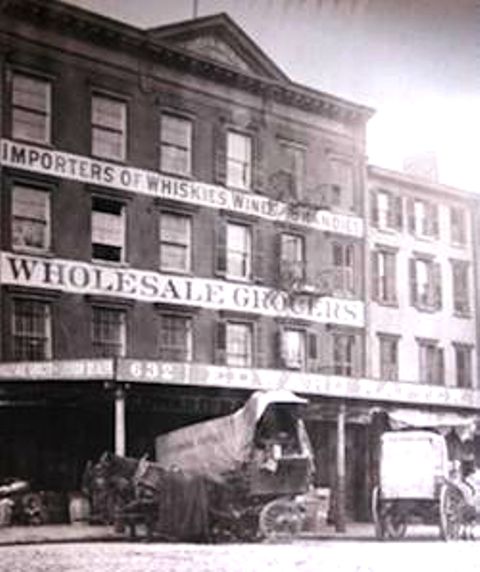
In 1889, 18-year-old John Rush got into trouble with the law when he was arrested for stealing some cash and promissory notes. He served three years of a four-year sentence at Sing Sing, and was pardoned by new Governor Roswell Pettibone Flower in 1892.
A year later, he joined the New York Fire Patrol No. 2. The fact that he lied on his civil service exam about prior felony convictions would come to haunt him briefly a few years later, but it never hurt his career.
It was during his service with the Fire Patrol that John Rush was discovered by members of the Fire Department for his many daring rescues.
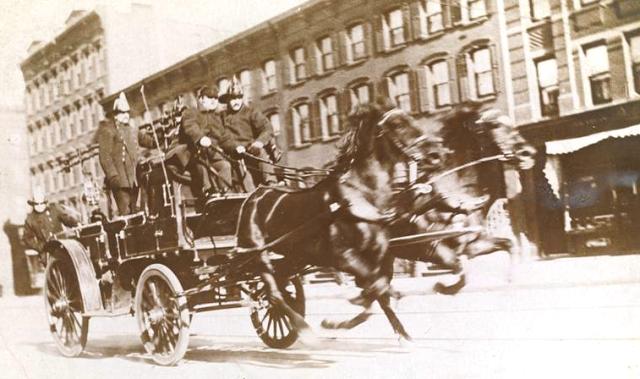
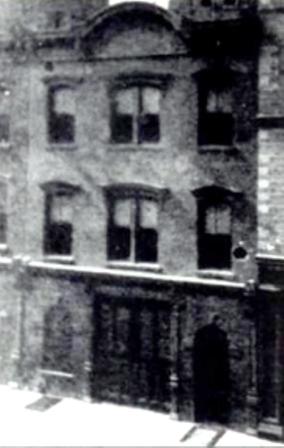
The New York Fire Patrol – officially the Fire Insurance Patrol — was organized in 1839 and funded by the New York Board of Fire Underwriters (NYBFU) to patrol lower Manhattan. The job of the patrolman or “Patrolio” was to discover fires and to prevent losses to insured properties.
The men worked alongside the volunteer firefighters, and, later, the paid firemen, and were in fact firefighters trained in the art of salvage and overhaul.
In 1867 a state charter was granted to the Fire Patrol to legally extinguish fires and conduct salvage operations throughout New York City. The New York Fire Patrol was the oldest paid fire service in the United States, and was the last insurance-funded fire salvage corps in the country when it was disbanded in 2006.
A year after he joined the Fire patrol, John Rush married Helen Patterson. Their daughter Sarah was born a year later – the same year that Patrolman Rush made his biggest fire rescue.
The daring feat took place on November 5, 1895, during a five-alarm fire that destroyed the Manhattan Savings Institution building and numerous other structures on Broadway and Bleecker Street.
John Rush and Patrolman Burnett were inside 648 Broadway when they heard two firemen shouting for help. The men had become trapped on the fifth floor of an adjacent building when the three upper floors fell in.
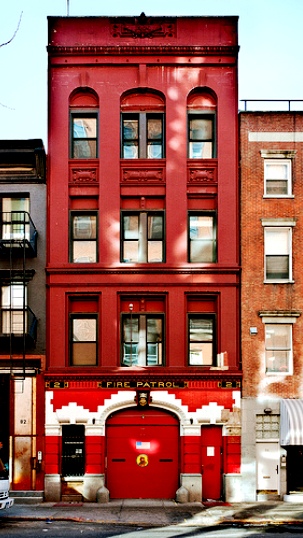
Rush and Burnett climbed out a window and balanced on a four-inch ledge and a small sign.
From there, the rescuers were still several feet below the trapped firemen, so Rush climbed onto Burnett’s shoulders and made a human ladder that just reached the firemen above him.

The trapped men held onto Rush and were able to make their way into the window just above Rush and Burnett.
As The New York Times reported, “It was a perilous undertaking, and it looked as though all would fall to the street.”
Seven months later, on June 8, 1896, John Rush was appointed to the New York Fire Department as a fireman for Engine Company No. 30.
He quickly advanced to the position of engineer (August 22, 1898), lieutenant (August 1, 1900), captain (April 15, 1904), and Battalion Chief, assigned to the Fifth Battalion (July 1, 1911).
While John was quickly rising among the ranks, tragedy struck time and time again on the home front. Sometime around 1907, John’s father was hurled from his fire engine on the way to a fire and killed instantly.
Soon after his father died, his wife took ill and was confined to a bed for three years. She died one month after he was promoted to battalion chief, in August 1911.
On January 9, 1912, John’s brother Charles E. Rush, a 35-year-old fireman with Engine Company No. 20, caught pneumonia while fighting the historic Equitable Life Building fire. He succumbed to his illness, leaving a wife and family. With both his father and brother gone, John now had to help support his mother and sister-in-law as well as take care of his own teenage daughter.
Dies While Trying to Save Children
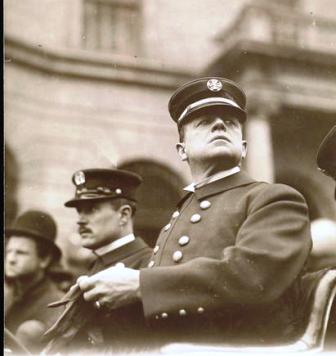
“It seems a strange irony of fate that a minor accident should have killed Chief Rush. I had almost come to think he bore a charmed life. One gets such ideas of men who pass through seemingly impassable dangers unscathed.”–Doctor Archer, St. Vincent’s Hospital, April 26, 1912
On April 25, 1912, John was being driven home in a horse-drawn buggy pulled by Victor. Victor was a large horse – more than 16 hands high – and had a reputation for being skittish. But John’s driver, John Harvey, was used to handling him.
The men had just passed Christopher Street when they got behind a truck, which caused Victor to get jumpy. The collar snapped under the strain and Victor plunged half out of his harness and raced toward a group of children who were crossing Hudson Street.
John Rush seized the reigns from his driver and pulled the horse back on his haunches to prevent a collision with the children.
The car reared and plunged, and the wheel of the buggy got caught in a car rail, causing the buggy to overturn. John and his driver were tossed from the vehicle. John Harvey landed on his feet.
John Rush plunged head first into the curb and fractured his skull.
According to news reports, John Rush had only time to ask Harvey to send for ex-Chief Croker when he went unconscious. Father McGrath of the Seamen’s Mission, who happened to be passing, issued last rites of the Church.
Victor took off running, but he halted in front of Hook and Ladder Company 5 at 96 Charles Street, where Chief Rush often stopped during inspection tours.
Seeing the driver-less buggy, the men went running toward a crowd that was gathering on Hudson Street. Recognizing the seriousness of the case, the firemen insisted that Dr. Archer of the Fire Department and
Dr. F. D. Smith be called. The two physicians hurried to
St. Vincent’s, arriving there as soon as the ambulance pulled up.
After determining that Chief Rush’s skull had been fractured, Dr. Archer sent for Dr. Joseph Bissell and Dr. George Stewart. The four doctors were preparing the operating table at 3:20 o’clock when Chief Rush died. Ex-Chief Croker and John’s 17-year-old daughter, Sarah, were at his side. John Rush was buried at the New York Bay Cemetery in Jersey City.
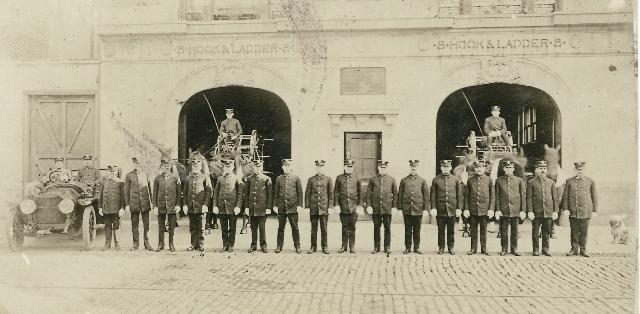
According to John’s sister, Florence Hannon, at the time of his death John’s estate was worth only $200. Although he made $3,300 a year as battalion chief, much of that money was given to his elderly mother and his widowed sister-in-law. John also couldn’t get life insurance, because he was considered too great a risk by the underwriters. A special fund was set up to help his mother and daughter — the author Jacob Riis, a friend of John’s, was one of the many people who contributed to the fund.
Victor Bolts on Varick Street
On August 1, 1912, Battalion Chief John Spencer was bringing pay envelopes to the men of Engine No. 30 when Victor got spooked by a vehicle on Varick Street and broke into a gallop. John Spencer’s driver, John Foote (I think everyone was named John back then) lost control, and the chief began ringing the gong as a warning to get people out of the way.

As the horse passed Grand Street, a Good Samaritan named Dennis Dermody tried to jump and catch the bridle, but he was thrown to the street and severely bruised. Victor eventually ran into a pushcart and fell, breaking his harness and scattering the pay envelopes all over the street.
Noting that this was the fifth time Victor had bolted, John Spencer recommended the horse “be disposed of.” I doubt there was any funeral procession for the former FDNY fire horse.






What a fascinating story! I am glad you are finishing your A to Z challenge. I am here today cruising by as I do my A to Z Road Trip.